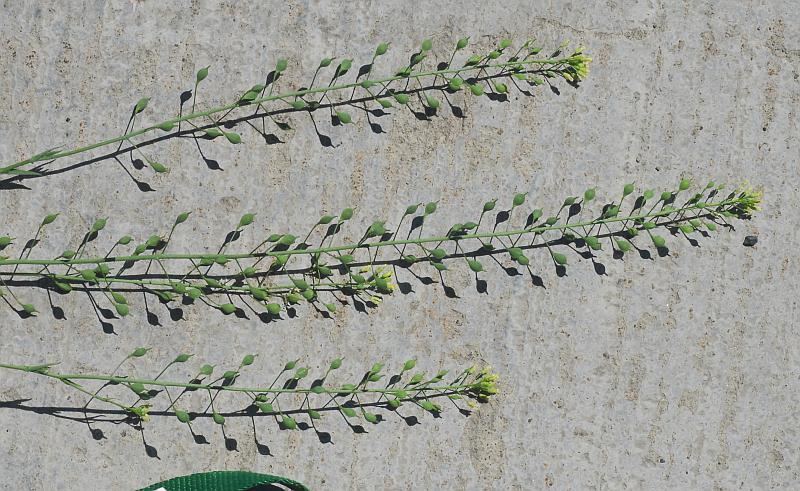Camelina microcarpa Andrz. ex DC.
Littlepod False Flax

Introduced
CC = *
CW = 3
MOC = 39
© SRTurner
Camelina microcarpa Andrz. ex DC.Littlepod False Flax | |
 |
Introduced CC = * CW = 3 MOC = 39 |
© SRTurner |
|
Family - Brassicaceae Habit - Taprooted annual forb. Stem - Ascending to erect, to 60 cm, sometimes few-branched in upper half, pubescent with rough, unbranched, spreading hairs 1.0-2.5 mm long and also shorter, forked and stellate hairs.
Leaves - Alternate and usually also a few basal at flowering. Stem leaves 1.5-5.5 cm long, the lower leaves short-petiolate, the upper leaves sessile, clasping with pointed auricles, the leaf blades oblanceolate to lanceolate or nearly linear in outline, the margins entire or minutely toothed, pubescent with branched and unbranched hairs.
Inflorescences - Terminal racemes or few-branched panicles, the flowers not subtended by bracts.
Flowers - Sepals 4, 2.0-2.5 mm long, narrowly oblong to oblanceolate, erect or ascending. Petals 4, 3-4 mm long, not lobed, but sometimes shallowly notched at the tip, light yellow, glabrous. Stamens 6. Filaments glabrous, 3 mm long. Anthers yellow, 0.2 mm long and broad. Ovary ovoid, 2-valved. Style 1.0-3.5 mm long, persistent in fruit and forming beak. Stigma globose.
Fruits - Ascending, less than 2 times as long as wide, obovoid or pear-shaped, tapered at the base to a short stalk above the attachment point of the perianth, elliptic in cross-section, slightly flattened parallel to the septum, the valves with an inconspicuous nerve in the middle, sometimes also with a faint network of smaller veins, the edges slightly raised but not winged, the valve tip extending into a beak into the persistent style, tardily dehiscent. Ovules 4-12 per locule. Seeds in 2 rows in each locule, usually 4 per locule (6-12 per fruit), 0.8-1.4 mm long, oblong-elliptic in outline, slightly longer than wide, the surface with a fine, netlike or honeycomb-like pattern of ridges and pits, reddish brown.
Flowering - April - September. Habitat - Pastures, crop fields, roadsides, railroads, open disturbed areas. Origin - Native to Eurasia. Lookalikes - Camelina sativa, Physaria spp., Neslia paniculata, other plants in the Brassicaceae. Other info. - This species has been found in most parts of Missouri, but is somewhat sporadic and uncommon. It has been collected only once in the state since 2000. It occurs across the continental U.S. but is by far the most common in the western half of the country. It can be identified by its small, pale yellow flowers and beaked, inflated fruits. Although exotic, the plant is not particularly aggressive in most areas of Missouri. It is best not to pull it up unless you are certain of its identity, since there are native lookalikes which are uncommon and endangered. Photographs taken at the Kansas City Zoo, 5-1-00 (DETenaglia); also near Three Forks, MT, 6-11-2015, Tallgrass Praire National Preserve, Chase County, KS, 6-5-2016, and Rocky Mountain National Park, Larimer County, CO, 8-1-2017 (SRTurner). |